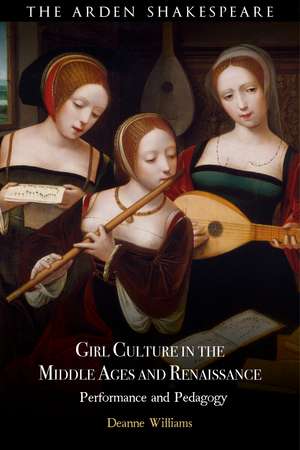Girl Culture in the Middle Ages and Renaissance: Performance and Pedagogy
Autor Deanne Williamsen Limba Engleză Hardback – 28 iun 2023
Preț: 513.20 lei
Preț vechi: 732.83 lei
-30% Nou
Puncte Express: 770
Preț estimativ în valută:
98.21€ • 101.91$ • 82.09£
98.21€ • 101.91$ • 82.09£
Carte disponibilă
Livrare economică 24 februarie-10 martie
Preluare comenzi: 021 569.72.76
Specificații
ISBN-13: 9781350343207
ISBN-10: 135034320X
Pagini: 336
Ilustrații: 40 bw illus
Dimensiuni: 156 x 234 x 24 mm
Greutate: 0.66 kg
Editura: Bloomsbury Publishing
Colecția The Arden Shakespeare
Locul publicării:London, United Kingdom
ISBN-10: 135034320X
Pagini: 336
Ilustrații: 40 bw illus
Dimensiuni: 156 x 234 x 24 mm
Greutate: 0.66 kg
Editura: Bloomsbury Publishing
Colecția The Arden Shakespeare
Locul publicării:London, United Kingdom
Caracteristici
It reveals the participation and importance of girls in painting, music, art history and classical studies and interweaves their relevance not only to girl culture but also to Shakespeare
Notă biografică
Deanne Williams is Professor of English and Theatre Studies at York University, Canada. She is the author of The French Fetish from Chaucer to Shakespeare (2004), which won the Roland Bainton Prize from the Sixteenth Century Society, and Shakespeare and the Performance of Girlhood (2014).
Cuprins
List of IllustrationsAcknowledgementsBiographical NoteNote on the TextIntroduction. Cultures of Girlhood Chapter One. A Theatre of Girlhood Gandersheim Girls Performance and Pedagogy Performing Girls, Performing Girlhood Humanist Hrotswitha Chapter Two. Performing Virginity Et tripident The Girlhood of the Virgin Mary 'Not fourteen' Chapter Three. The French Girlhood of Anne Boleyn Fille d'Honneur The Girlhood Reading of Claude de France Anne Boleyn's Songbook Henry VIII and the Afterlife of Girlhood Chapter Four. Translating Daughters A Girl at her Desk A Girl and a Play A Girl on Stage Chapter Five. Faithful Shepherdesses 'Courting of the Shepheardesses' 'Eliza, Queen of Shepheardes' 'Captive or Sheppardesses life' Chapter Six. Wanton Ambling Nymphs A Glittering Procession Milksop Ladies 'Enter a Nimpth' 'Fair Silver-buskined Nymphs' Chapter Seven. Global Girlhoods A Girl in the World Spice Girl A Quintessence of Cordial Conclusion. Girl my Greatness NotesBibliographyIndex
Recenzii
This brilliant and transformative study completely redefines the conventional accounts of medieval and early modern theatre by exploring the wide range of evidence (which has been almost completely ignored) for girls acting in plays, usually ones written specifically for them. From Germany and France to drama in the English court, schools, households and streets, Williams is a sure guide to a field of performance we had for so long managed to forget about.
Girl Culture in the Middle Ages and Renaissance is suffused with an affirmative spirit, revealing girlhood as a creative oasis in diverse medieval and early modern women's lives. With dazzling learning and linguistic dexterity, Williams illuminates dramatic writing and performance, religious devotion, visual art, song and book culture. The archival evidence she mobilizes establishes, irrefutably, "a whole new cultural tradition".
In a momentous departure from previous studies of both the advent of actress on the English stage as well as from critical work on women's writing, this pathbreaking book demonstrates that while female performers were indeed excluded from the public stage in Elizabeth and Jacobean England, girls rather than women nonetheless participated in a wide range of entertainments and enactments from the medieval to the early modern period. Girls of all ages were not just singers or bit-part players, but also writers and composers and were actively engaged in significant acts of performance and cultural production. Deanne Williams' startling insights into this girl culture are derived from a wealth of meticulous archival research and from acute critical assessment of both new and more familiar texts of the period.
By identifying "girl culture" as a richly multifaceted phenomenon and locating it at the heart of her study of pre-modern performance, Deanne Williams offers a transformative new perspective on both theatre history and the history of childhood. Transnational and multilingual in its scope, expansive in its chronological reach and methodologically capacious, this bold and ambitious book makes plain the remarkable and shaping role girls have played in the production of culture.
Girl Culture in the Middle Ages and Renaissance is suffused with an affirmative spirit, revealing girlhood as a creative oasis in diverse medieval and early modern women's lives. With dazzling learning and linguistic dexterity, Williams illuminates dramatic writing and performance, religious devotion, visual art, song and book culture. The archival evidence she mobilizes establishes, irrefutably, "a whole new cultural tradition".
In a momentous departure from previous studies of both the advent of actress on the English stage as well as from critical work on women's writing, this pathbreaking book demonstrates that while female performers were indeed excluded from the public stage in Elizabeth and Jacobean England, girls rather than women nonetheless participated in a wide range of entertainments and enactments from the medieval to the early modern period. Girls of all ages were not just singers or bit-part players, but also writers and composers and were actively engaged in significant acts of performance and cultural production. Deanne Williams' startling insights into this girl culture are derived from a wealth of meticulous archival research and from acute critical assessment of both new and more familiar texts of the period.
By identifying "girl culture" as a richly multifaceted phenomenon and locating it at the heart of her study of pre-modern performance, Deanne Williams offers a transformative new perspective on both theatre history and the history of childhood. Transnational and multilingual in its scope, expansive in its chronological reach and methodologically capacious, this bold and ambitious book makes plain the remarkable and shaping role girls have played in the production of culture.
